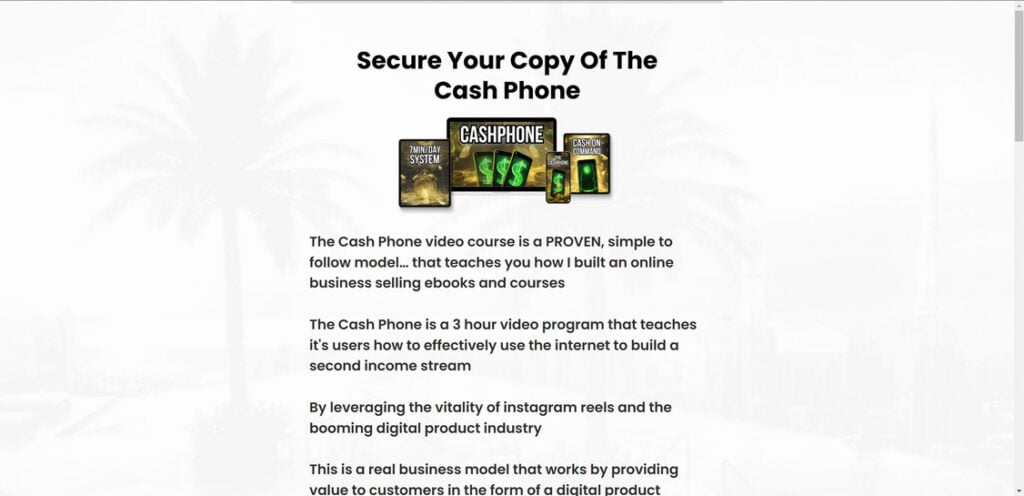In the vast and often murky world of online money-making schemes, few offers seem more enticing than the promise of easy passive income earned with minimal effort. Scammers and shady marketers frequently leverage this universal desire to line their own pockets, crafting increasingly manipulative ploys and sales funnels aimed at exploiting people’s hopes and dreams.
One such scheme making the rounds recently is called Cash Phone or Cash Phone Original, which uses social media ads and faked testimonials to promote a so-called “7 minute phone trick” for generating automatic cash. But can turning your phone into an ATM really be as simple as they claim?
Let’s take a detailed look under the hood at how the Cash Phone scam operates in order to protect potential victims.

Cash Phone Scam Overview
Cash Phone, also marketed under the name Cash Phone Original, first gained attention through Facebook and Instagram ads featuring short videos that claimed users could start earning up to $500 per day within just 7 minutes of activating this system.
The offer is classic bait promising untold riches with virtually no real work involved. Of course, the only way to get access to this supposed automated income stream is to pay for the Cash Phone program first.
Various video sales letters and fake testimonials are used to further hype up the effectiveness of the so-called “phone trick,” with actors pretending to be impressed by how much money they’ve made with no skills or experience required. Images of expensive cars, vacations and mansions are shown to reinforce the message that this is a fast track to wealth.

In reality, there is no shortcut to turning a phone into an automated cash-producing tool. The actual product appears to be a basic digital download providing generic tips on selling online products or leveraging social media for revenue. Despite flashy promises of easy passive income, users typically end up with underwhelming generic advice they could find elsewhere for free.
This scam has been also investigated by Jordan Liles on his YouTube channel, where he offers a detailed video on the subject. We recommend watching his content for a comprehensive understanding of the scam.
Next, let’s break down exactly how scammers carry out this scam from start to finish.
How the Cash Phone Scam Works
The Cash Phone scam follows the blueprint of many online money-making grifts by using a deceptive sales funnel to portray value where none exists. Here’s an in-depth look at each step of the process:
Step 1: Entice With Outlandish Claims
The first component of the Cash Phone scam is the initial bait meant to capture people’s attention and interest. Short video ads on social media make incredulous claims such as “Generate up to $500 per day with just your phone and 7 minutes” or “Discover the 7-minute trick for earning passive income.”
For anyone struggling financially, promises of easy money flowing with hardly any effort required are incredibly enticing. The ads target people’s desires to improve their lives and bypass financial constraints.

Step 2: Dazzle With Manufactured Proof
The next step in the Cash Phone sales funnel is trying to back up those jaw-dropping income claims with what appears to be solid proof in the form of testimonials. Video sales letters feature actors portraying ordinary people who’ve used Cash Phone and seen amazing results.
They tell tales of being able to quit their jobs, buy expensive items, and dramatically change their lifestyles thanks to this “7 minute trick.” Of course, these testimonials are completely fabricated. No real evidence is ever shown, just verbal claims shot in high production quality to seem legitimate.
Step 3: Build Urgency With Limited Time Offers
Scarcity is a powerful tactic scammers use to fuel impulse purchases and prevent consumers from thinking critically. Cash Phone relies heavily on false urgency by claiming you need to act fast before the opportunity disappears.
Phrases like “only 37 spots remaining at this price” and “sale ends soon” encourage people to buy immediately out of fear of losing out on massive promised profits. Countdown timers are used to further amplify the now-or-never scarcity effect.
Step 4: Capture Payments and Upsell Relentlessly
Once credit card information is entered, customers are typically charged an initial ~$47 fee to buy into the supposed Cash Phone system. But the upselling continues aggressively from there, with various add-ons and premium “coaching” packages pushed very forcefully using psychological triggers.
For example, to unlock the supposed full money-making potential, you may have to pay hundreds extra for unlimited profit licensing rights. Additional upsells for overpriced monthly subscriptions are also pushed very hard after the initial payment is captured.
Step 5: Underdeliver With Generic Info
After collecting payments from customers under the false pretense of easy passive income, what most people end up receiving is lackluster generic information. The promised “7 minute trick” does not exist.
Instead you may get a basic PDF or video files essentially telling you to monetize social media or create and sell online courses and digital products. This extremely simplistic advice can be found almost anywhere online for free.
Of course, there is no automation involved and no real shortcut to making money online without having skills, expertise or work ethic. The product completely fails to deliver on the dream sold by the slick marketing.
Step 6: Make Refunds Difficult
Many users end up deeply unsatisfied, even irate, once they realize the horrendous gap between what Cash Phone advertises and the useless recycled guidance they actually provide. But getting a refund is made intentionally difficult by the scammers.
Burying terms deep in the fine print, imposing absurdly short refund windows and simply ignoring refund requests are some of the unethical tactics used to prevent refunds. Some customers report waiting weeks or months without ever receiving refunds specifically promised to them.
The goal is to keep every dollar possible even when people legitimately feel cheated. Difficult refund policies also help dissuade credit card chargebacks.
What To Do If You’ve Fallen Victim to the Cash Phone Scam
For anyone who has already paid and provided personal information to these unscrupulous marketers, here are some important steps to take right away:
1. Request an Immediate Refund
Contact Cash Phone support immediately demanding an automatic refund due to feeling misled by deceptive marketing. Cite the huge disconnect between actual product and sales pitch. Be firm and persistent. Although getting a refund may prove challenging, refusing to take no for an answer forces them to respond. Submit written complaints as well.
2. Dispute the Charges
If refund requests are ignored or denied, quickly dispute the charges with your credit card company. Explain it is an illegitimate scam purchase that utterly failed to match misleading advertising. Provide evidence and be fully detailed in describing the deception.
3. Cancel Any Recurring Charges
Double check for any recurring billing or auto-renew subscriptions established during checkout. Cancel all future billing immediately to avoid being further charged every month for an ineffective program.
4. Submit Fraud Reports
File detailed scam and fraud reports with the FTC, state attorney general, and BBB to help shut these shady marketers down. Warn others by leaving negative reviews everywhere the Cash Phone ads appear. This helps prevent more innocent people from being duped.
5. Monitor Accounts Closely
Keep close watch on credit cards and bank accounts used to purchase Cash Phone for any suspicious activity. Scammers sometimes sell or abuse financial information. Report any unauthorized transactions right away.
Change passwords and enable two-factor authentication for added security after falling victim to a scam.
The Bottom Line
In the end, Cash Phone is just the latest in a long parade of money-making scams exploiting people’s desire for financial freedom with minimal effort. Using deceptive marketing and manufactured “proof,” these shady promoters overhype ineffective products just to profit from other’s hopes and dreams.
No legitimate business needs to make outlandish income claims then underdeliver with recycled generic advice. True success online requires real expertise, determination and work ethic. Anyone promising unfathomable wealth overnight with no real specifics can be assumed a con artist.
Hopefully by understanding the deceitful tactics scammers use, we can avoid falling victim when that next shiny offer of easy riches crosses our path. With knowledge and vigilance, we can see through these shams and focus time and money only on ethical, worthwhile opportunities. Please share this article to help protect others from predatory online scammers.
Frequently Asked Questions
1. What is the Cash Phone scam?
Cash Phone is a deceitful money-making scam that uses manipulated ads and fake testimonials to promote a non-existent “7 minute phone trick” for earning automated income. Victims pay real money for this fictional system but receive only basic, generic information in return.
2. How does the Cash Phone scam work?
The scam uses manipulated videos and fake testimonials to advertise outlandish promises of easy passive income. After capturing payments, customers receive only generic, low-quality advice. Refunds are deliberately made difficult.
3. Is Cash Phone real or fake?
Cash Phone is 100% fake. There is no actual “7 minute trick” to earn money with a phone as claimed. Everything is fabricated to scam people out of their money.
4. What do you actually get with Cash Phone?
All you get is generic, basic information on making money online by selling digital products or leveraging social media. Nothing unique or proprietary and definitely no automation.
5. Can I get a Cash Phone refund?
Refunds are notoriously difficult but persistently demanding one and disputing credit charges may work. File complaints & warn others. Monitor bank accounts closely afterward.
6. Is there really a 7 minute phone trick?
No, there is no actual 7 minute phone trick to earn passive income as promoted. That claim is a complete fabrication to entice purchasers.
7. How can I avoid Cash Phone scams?
Focus on ethical opportunities. Beware claims that seem too good to be true. Understand scammers use deception about ease and speed of income. Never rush purchases.
8. Are Cash Phone testimonials real?
No, all testimonials making outrageous income claims are fabricated by paid actors. No actual users ever validate the efficacy of Cash Phone because it simply doesn’t work.










